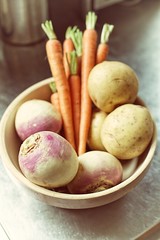| Fall Planting in Progress (Photo credit: EatandLiveGreen) |
Some flowers, like pansies, for example, actually prefer cooler weather. So in a way, you can bracket your entire growing year with pansies and the related violas, starting them early in the cool spring, and then planting more in the cool autumn. Certain types of impatiens plants also seem to do quite well as the hot summer gives way to cooler autumn temperatures. It's long been known, too, that ornamental (and edible!) kales and cabbages last long into the autumn, and mums are another very hardy flowering plant that you can use to brighten up the garden.
| Root Vegetables (Photo credit: frank3.0) |
You can also check for seed packets in early August, looking for vegetables that can be planted even later. You can ask the advice of the local garden center to be sure which ones work best for your Zone, but look for the ones that list the shortest growing season on the packet. For these vegetables, you would prepare the garden beds all over again, removing all dead and finished vegetation and spreading fresh mulch and compost so that some nutrients are restored to the soil. Some vegetables (including root vegetables like beets and carrots, and leafy greens like lettuce, mustard, collards, and kale) can even grow through the first early frosts and yield a harvest for you - some will even taste sweeter, as the cool weather brings out the sugars in the plants.
As you put some parts of your garden to bed for the autumn and winter, other parts can still be vital and growing, while still others can be planted afresh and begin a new growing season entirely. If you enjoy your gardening and really don't want to let it go yet, there are ways to extend the pleasure just a little longer. Bring in some mums and pansies and plant some root vegetables and greens, and let the gardening continue for several more weeks - or maybe even months! (And if you want to try gardening year-round - which I am trying this year for the first time myself - see Eliot Coleman's excellent book, The Four-Season Harvest


No comments:
Post a Comment